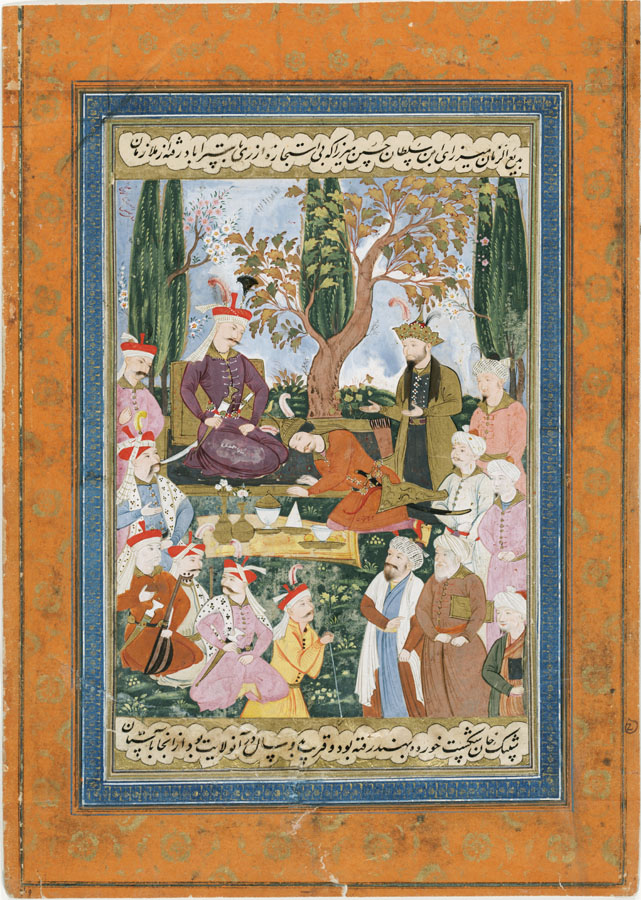Location: Free Library of Philadelphia, Philadelphia Pa., Lewis 33 P107.
Mount: orange mount with gold 33.0 x 23.4 cm; blue collar.
Written surface: 23.7 x 15.2 cm.
Painting: 19.9 x 15.2 cm.
Text references: J.K., p.393 lines 5-7.
Date of this event: winter of 916/1510-11.
The place was Jahanārā Garden outside Herat. According to text that adjoins the painting, Badiʿ al-Zamān left the city of Ray without permission and went to Estarabād, where he lost a battle to Šāhibeg Khan, and subsequently fled to India. There he remained for about two years, only to return thereafter to the feet and protection of Shah Esmāʿil.
The name of Badiʿ al-Zamån weaves in and out of the narrative for a goodly number of pages, usually fighting or fleeing the Uzbegs, and never accomplishing his goal. This is the second time in this text that Badiʿ al-Zamān is shown prostrate at the feet of Shah Esmāʿil. The first time is in 915/1508 (cf. JK_346) when he escaped from death at the hands of Šāhibeg Khan and was brought before Esmāʿil who welcomed him and gave him refuge and protection in the city of Ray. Here, almost two years later, the tone is quite different: Badiʿ al-Zamān had violated the conditions of his safe haven and was now suffering the admonishment of the shah for having done so.
Shah Esmāʿil is seated on a carpet in the upper left, his hand resting on the hilt of a dagger inserted in his belt, and observing the actions of Badiʿ. A second carpet is spread in front of the shah, on which has been placed the usual spread of fruit, drink, and sweets. In a semi-circle on the left stretching to the left foreground are six qezelbāš emirs. They are variously seated, standing, or leaning on walking sticks, conversing together and witnessing the event. On the right is a second group of similar number, disposed in rows forming a pyramid; they are all bearded, wearing turbans and long robes and can be identified as members of Badiʿ al-Zamān’s entourage. One last individual of unknown identification appears standing in the upper right, just behind the prostrated Badiʿ. He wears a full length top coat with fur collar, and a jewel encrusted crown with a pointed tip protruding from the center that resembles a Timurid helmet. He beckons towards Esmāʿil with his arms outstretched, palms up, as if presenting or explaining the actions of the person prostrate before him. Inscriptions, presumably of later date, are written on two of the figures, identifying them as Shah Esmāʿil and Badiʿ al-Zamān. The painting is not signed or dated, but the style makes an attribution to Moʿin, perhaps with studio assistance, quite plausible.
For another Moʿin painting from the episode of
Badiʿ al-Zamān, see Manuscript.M, folio 165.
Painting references:
Sims, Safavid_2002, fig.10.5 (ill. in black and white)..
Provenence: Formerly in the John Fredrick Lewis Collection.
Photo used by permission of the Rare Book Department, Free Lbrary of Philadlphia.
Robert Eng
Last Updated: August 1, 2011 | Originally published: August 1, 2011
